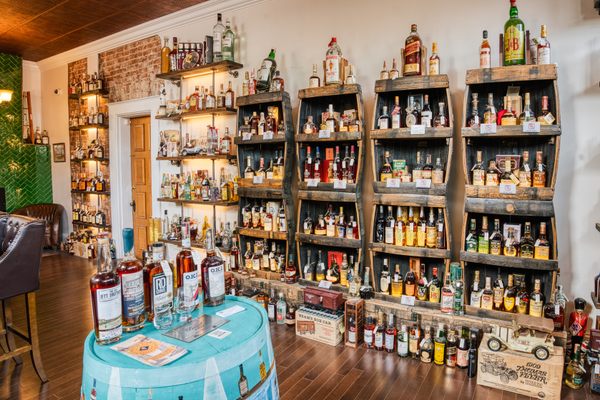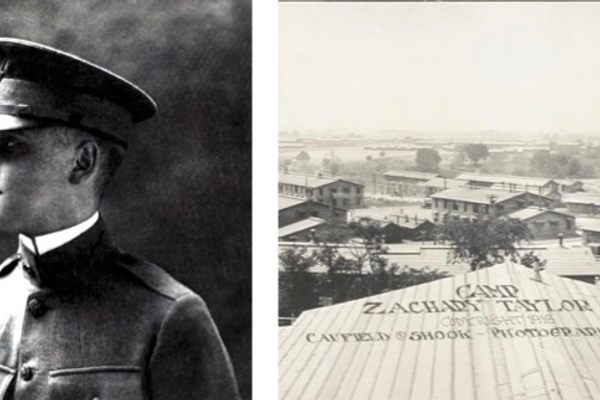How Sherry Became the Secret to Great Scotch
Scottish and Spanish spirits have a symbiotic relationship.

Williams & Humbert, the cathedral-esque sherry bodega located in Jerez de la Frontera, Spain, brims with sepia-toned bullfighting posters, creaky Castilian furniture, and cobwebbed oak barrels. Sometimes, it even hosts Andalusian horse dancing set to the strums of flamenco guitar. But venture just beyond its stately main hall, and you could be in the Scottish Highlands: There, barrels branded with “The Macallan” stretch as far as the eye can see.
To most people who visit the Sherry Triangle—the wine region of southwest Spain bounded by Jerez de la Frontera, Sanlúcar de Barrameda, and Puerto de Santamaría—such a sight can be disorienting. But for centuries, the scotch and sherry industries have had a deep-rooted symbiosis that has kept both afloat through the ages, despite consumer taste varying wildly.
This relationship has its roots in 1587, when English privateer Sir Francis Drake paraded into Britain with 2,900 casks of sherry. They* were the spoils of his assault on the city of Cádiz, known as “Singeing of the King of Spain’s Beard.” The kidnapped wine was a sensation among the elite and sparked a sherry craze in Britain—and by affiliation, Scotland—that lasted centuries. Shakespeare, an avid sherry drinker, mentioned it at least 40 times in his works, and famously writes in Henry IV that a good sherry “makes the brain sharp, quick, and inventive; full of nimble, fiery, and beautiful ideas. The voice and tongue give birth to those ideas which, when they grow up, become excellent wit.”
Over time, this unslakable thirst for sherry left a surplus of empty barrels rolling around the British Isles. So it was only a matter of time before the Scots started storing their local moonshine, a clear distillate called uisge beatha (“water of life”), inside them. “Around 1800, distillers in Scotland realized that putting this clear spirit in a barrel not only made financial sense, but also made the liquid look and taste better,” says Mark Gillespie, founder of the WhiskyCast podcast.
It’s hard to overstate the importance of this development. Stuart MacPherson, Master of Wood at The Macallan, calls wood the “singular most important factor in creating a whisky’s character, since up to 80 percent of its final flavor comes from the cask.” (As evidenced by his title, MacPherson’s work involves sourcing timber from forests on two continents, overseeing barrel production in Spain, and transporting the seasoned casks to Scotland.)
That, along with the 1831 invention of the column still (which allowed for continuous distillation), paired with a newfound demand from France in the 1880s (due to a phylloxera outbreak that had devastated French brandy production), cemented scotch whisky’s place in the European market. By 1900, the scotch industry was booming. Across Scotland, warehouses were stacked floor to ceiling, all of them with sherry barrels filled with whisky.

Apart from a hiccup in production during World War II, scotch continued to see rising popularity, especially in the United States following Prohibition. But by the 1950s and ‘60s, a period many consider to be the “Golden Age” of scotch, the industry was changing. Newly-enacted “Standards of Identity” laws in the U.S. mandated that all bourbon be aged in new oak, which created a sudden glut of American oak barrels that scotch whisky houses could buy up at a fraction of the price of sherry barrels. “Whatever was cheapest, that’s what the distilleries purchased,” says Gillespie.
The nail in the coffin for the sherry cask came in 1981, when the Spanish government began requiring that all sherry be bottled in Spain prior to export. Any sherry casks that were sold to whisky makers in Scotland had to be shipped dry, which made the wood more prone to taint and cracking. Worse, sherry was already in dire straits back in Spain: Downward-spiraling prices, a sector-wide drop in quality, and evolving consumer tastes meant people weren’t buying sherry like they used to. Hardly anybody—neither bodegas (wine cellars) nor the whisky makers—was investing in new sherry casks, and Jerez’s cooperages came to a virtual standstill.
The gradual switch from sherry to bourbon barrels would have profound, lasting effects on the profile of scotch. “The signature flavors in a sherry cask-matured scotch are golden raisins, prunes, incense, and clove, while American oak tends to impart vanilla, coconut, sweet spice, and caramel,” says Dave Broom, spirits writer and author of The World Atlas of Whisky. “They’re completely different styles.”
Many whisky makers embraced the trend. In the 1970s and ‘80s, as spirits such as vodka and white rum became more and more fashionable (especially in the U.S.), the scotch industry was keen to experiment with lighter styles. American oak-matured whisky fit that bill. “Because scotch is driven by blends, blenders were able to slowly and subtly shift the profile of their spirit to suit this new palate,” Broom says. Most scotch drinkers didn’t even notice.
Yet in the sea change away from old sherry barrels, a few manufacturers dug in their heels—in sometimes questionable ways—to preserve scotch’s time-honored sherry flavor. For instance, from the 1960s through the 1980s, there was widespread use of a syrupy, boiled-down sherry product known as paxarette. “In those days, if you had an old, tired cask, you’d slop in some pax, roll it around, and it’d taste like sherry again,” says Broom, adding that the substance was outlawed in scotch production in 1989.
Shrewd distilleries such as The Macallan foresaw sherry’s demise and started dabbling in the art of vertical integration. If the bodegas could no longer provide quality casks, then it was time to do direct business with the cooperages and bodegas in Jerez. As early as the 1950s, The Macallan began snapping up new barrels and paying wineries in the area to “season” them with sherry before shipping them (empty, of course) to Scotland.

It paid off: Today, the scale of The Macallan’s operation is almost unfathomable. “There are four cooperages in Jerez, and we work with three of them,” says MacPherson. “Eighty-five percent of their barrels go to Edrington,” Macallan’s parent company, “and most of those go to The Macallan.” Around 70,000 new sherry-filled casks bearing The Macallan’s logo are marinating in Jerez as we speak. (The coopering exhibit at The Macallan’s new $189 million visitor center sheds light on this little-known process.)
Jerez’s bodegas and cooperages are bustling again, thanks, in large part, to heavy investments by the scotch industry. Williams & Humbert, one of The Macallan’s partner bodegas, has seen an uptick in sales after years of decline, and they have the capital to experiment with new products again. Their organic fino, released in July, is a first in the industry. “Sherry is back in style,” says Rafael Medina Martínez, director of operations.
In the same vein, Lustau broadened its repertoire in 2017 to include a new sherry-based vermouth, and some Tío Pepe bottles just got a pop-art makeover inspired by Andy Warhol. These developments hint that the centuries-old sherry houses are nimble enough to capitalize on the worldwide sherry craze.
According to the Regulatory Council of Sherry Wines, offbeat sherry types such as amontillado, oloroso, and palo cortado saw a seven percent increase in sales in 2017, while premium sherries saw a two percent increase. (Considering that the sherry market was in virtual freefall until recently, these seemingly minor gains are significant).

Nearly a third of the 60,000 barrels at Williams & Humbert are dedicated solely to The Macallan. But with the price of a single seasoned sherry cask hovering around $1,300—astronomically more expensive than ex-Bourbon casks, according to MacPherson—it all begs the question: Is scotch aged in sherry-seasoned wood inherently better than the stuff matured in American whiskey barrels?
“It comes down to individual taste,” says Gillespie. “There are people who hate the heavy, tannic notes of sherry-cask whiskies and people who love them. Sometimes the best whiskies result when you blend both types.” Broom goes as far as to say that the use of sherry casks is “not a prerequisite for quality” in scotch, adding that many of the sherry-aged whiskies on the market are aged in wood so old that the influence of sherry is basically nil.
Does sherry have a place in the 21st century? That question dogged Chris Hoban, the brand ambassador of Isle of Raasay, a new whisky company that began distilling in September. “The spirit we’re aiming to produce is on the lighter side, but … I’m interested in emulating whiskies from the past in addition to creating new whiskies for the future.” To many young up-and-comers such as Hoban, scotch isn’t just about flavor profiles, it’s also about heritage. He’s taking his first recon trip to Jerez in September.
Whether you’re a world-renowned name like The Macallan or a newcomer like Isle of Raasay, in the world of scotch and sherry, you always have to have one foot in the past and the other in the future. The tables could very well turn in sherry’s favor once again (hey, things do look promising). Citing a conversation with the people at The Glenlivet when they were adding a new wing to their operation, Hoban says: “They were making decisions based on a 100-year forecast. One hundred years. There aren’t many industries that have to think that far ahead.”
Correction: This article previously referred to several casks of sherry as bottles. They are different receptacles.
Gastro Obscura covers the world’s most wondrous food and drink.
Sign up for our regular newsletter.

























Follow us on Twitter to get the latest on the world's hidden wonders.
Like us on Facebook to get the latest on the world's hidden wonders.
Follow us on Twitter Like us on Facebook